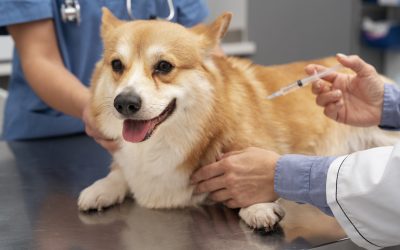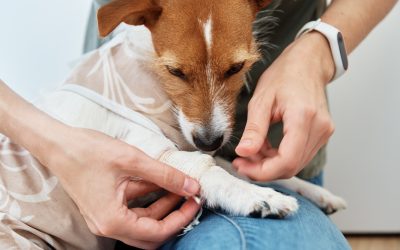How to Treat Osteoarthritis in Dogs [Cause, Signs & More]

What Is Osteoarthritis in Dogs?
Osteoarthritis is a degenerative joint disease that causes pain and discomfort in dogs. It occurs when the cartilage in the joints breaks down over time, leading to inflammation and stiffness. This condition commonly affects older dogs, but it can also occur in younger dogs due to genetic factors or previous injuries. Osteoarthritis can significantly impact a dog’s quality of life, making it essential to address the condition promptly and provide appropriate treatment.
What Are the Four Stages of Osteoarthritis in Dogs?
Osteoarthritis in dogs progresses through four stages.
- Stage 1: mild cartilage deterioration may occur with minimal joint changes. Dogs may experience occasional stiffness and discomfort.
- Stage 2: Involves moderate cartilage loss, leading to more noticeable pain and stiffness.
- Stage 3: Significant cartilage erosion, joint deformities, and limited mobility characterize the third stage.
- Stage 4: the cartilage is almost completely worn away, causing severe pain, limited joint movement, and potential bone-on-bone contact.
Risk Factors for Osteoarthritis in Dogs
Several factors increase a dog’s risk of developing osteoarthritis. These include obesity, which places excess stress on the joints; previous joint injuries or surgeries; genetic predisposition; certain breeds, such as Labrador Retrievers and German Shepherds, being more prone to the condition; and advanced age. Understanding these risk factors can help dog owners take preventive measures and monitor their dog’s joint health.

Causes of Osteoarthritis in Dogs
There are various causes of osteoarthritis in dogs. One common cause is joint wear and tear due to the natural aging process. Dogs with previous joint injuries or surgeries are also more susceptible to developing osteoarthritis. Additionally, genetic factors can play a role, with certain breeds being more prone to the condition. Other underlying conditions, such as hip dysplasia or obesity, can contribute to developing osteoarthritis in dogs.
Signs of Osteoarthritis in Dogs
Recognizing the signs of osteoarthritis in dogs is crucial for early intervention. Dogs with osteoarthritis may exhibit lameness or stiffness, especially after rest or exercise. They may have difficulty rising or lying down and may limp or favor certain limbs. Other signs include reluctance to jump, play, or engage in physical activity, as well as behavioral changes like irritability or aggression. It’s important to consult a veterinarian if any of these symptoms are observed in a dog, as early detection and treatment can significantly improve their quality of life.
Diagnosis of Osteoarthritis in Dogs
To diagnose osteoarthritis in dogs, veterinarians typically perform a thorough physical examination, evaluate the dog’s medical history, and assess the symptoms the dog owner reports. Radiographs (X-rays) may be taken to visualize the joint changes and confirm the diagnosis. Additional diagnostic procedures like joint fluid analysis or advanced imaging techniques may be necessary in some cases. A proper diagnosis is essential to develop an effective treatment plan for managing osteoarthritis in dogs.
Eight Treatment Options for Osteoarthritis in Dogs
1. Weight Management
Maintaining a healthy weight is crucial for dogs with osteoarthritis. Excess weight strains the joints, exacerbating the condition’s symptoms. A veterinarian can guide appropriate weight management strategies, including a balanced diet and portion control, to help reduce the dog’s pain and improve their mobility.
2. Modified Exercise and Rehabilitation
Regular exercise is essential for dogs with osteoarthritis, but it should be modified to minimize joint stress. Low-impact activities like swimming or walking on soft surfaces can help strengthen muscles and improve joint flexibility. Physical therapy and rehabilitation techniques, such as range-of-motion exercises and hydrotherapy, can also benefit significantly.
3. Joint Supplements
Joint supplements containing ingredients like glucosamine and chondroitin sulfate can help support joint health in dogs with osteoarthritis. These supplements aim to promote cartilage repair and reduce inflammation. It’s important to consult a veterinarian for guidance on choosing the most suitable joint supplement for a dog’s needs.
Non-Steroidal Anti-Inflammatory Drugs (NSAIDs)
Veterinarians commonly prescribe NSAIDs to manage pain and inflammation associated with osteoarthritis in dogs. These medications help reduce discomfort and improve mobility. However, it’s crucial to use NSAIDs under veterinary supervision, as they can have potential side effects. Regular monitoring and follow-up appointments are necessary to ensure the dog’s well-being.
Polysulfated Glycosaminoglycans (PSGAGs, Adequan) and Polyglycan SA
PSGAGs, such as Adequan, and Polyglycan SA are injectable medications that can help improve joint health and reduce the progression of osteoarthritis in dogs. These medications work by promoting cartilage repair and reducing inflammation. Veterinarians may recommend these treatments as part of a comprehensive osteoarthritis management plan.
Glucosamine/Chondroitin Sulfate Containing Agents
Glucosamine and chondroitin sulfate are commonly included in joint supplements and can also be administered separately as oral medications for dogs with osteoarthritis. These agents aim to reduce pain and inflammation while supporting joint health. Consulting a veterinarian is essential to determine the appropriate dosage and administration method.
Omega-3 Fatty Acids
Omega-3 fatty acids, found in fish oil supplements, have anti-inflammatory properties that can benefit dogs with osteoarthritis. These supplements help reduce joint inflammation and promote overall joint health. It’s important to choose high-quality supplements specifically formulated for dogs and follow the recommended dosage guidelines.
4. Pain Management Drugs
In severe cases of osteoarthritis, a veterinarian may prescribe pain management drugs to provide relief. These medications, which may include opioids or other pain-relieving agents, are used when other treatment options have not adequately controlled the dog’s pain. Close veterinary monitoring and regular follow-up appointments are essential when using these medications.
5. Implement Ramps, Cubes, and Non-Slip Flooring
Modifying the dog’s environment can significantly improve their mobility and reduce the risk of falls or injuries. Implementing ramps and cubes can help dogs with osteoarthritis navigate stairs or high surfaces more easily. Using non-slip flooring throughout the home can provide better traction and stability for dogs with joint pain.
6. Provide a Comfortable, Cushioned Bed
A comfortable bed with supportive cushioning is essential for dogs with osteoarthritis. Orthopedic beds or memory foam mattresses can help alleviate joint pressure and provide more restful sleep. Elevated beds can also be beneficial for dogs with difficulty rising or lying down.
7. Allocate Time for Regular Grooming Sessions
Regular grooming sessions are essential for dogs with osteoarthritis. This includes brushing their coat, trimming their nails, and cleaning their ears. Grooming should be done with care to avoid excessive joint stress or discomfort. Consider seeking professional grooming services to ensure the dog’s well-being if necessary.
8. Utilize Hydrotherapy for Therapeutic Benefits
Hydrotherapy, such as swimming or underwater treadmill sessions, can provide therapeutic benefits for dogs with osteoarthritis. The buoyancy of water reduces joint impact while allowing for gentle exercise. Hydrotherapy helps improve muscle strength, joint flexibility, and overall mobility.

What’s the Average Cost of Treating Osteoarthritis in Dogs?
The cost of treating osteoarthritis in dogs can vary depending on various factors, including the severity of the condition, chosen treatment options, and geographic location. Diagnostic tests, medications, supplements, and regular veterinary monitoring contribute to the cost. It’s important to consult a veterinarian to estimate the specific costs associated with treating osteoarthritis in a dog.
The Importance of Rehab Coverage If Your Dog Is High Risk for Osteoarthritis?
Pet insurance can be a valuable tool in managing the costs of treating dog osteoarthritis and other veterinary expenses. By having a pet insurance policy in place, you can have peace of mind knowing that you can provide medical care for your furry companion without worrying about the financial burden. Pet insurance can help cover the costs of veterinary consultations, diagnostic tests, medications, and even specialized treatments such as rehab and hydrotherapy, in some cases.
Reimbursement
This method is the most common for pet insurance companies. You pay out of pocket for the veterinarian bill, and then the insurance company reimburses you for what’s covered under the insurance plan. The steps look like this.
- You pay the vet bill after your dog’s visit.
- You fill out the pet insurance claim form.
- Submit the claim form and other required documentation to the insurer.
- After the claim is approved, you will be reimbursed for eligible expenses.
What Does Odie Pet Insurance Cover?
Pet insurance covers various veterinary expenses, providing financial protection and peace of mind for pet owners. Here are the details of the coverage options offered by Odie Pet Insurance:
Illness & Injury Plan
The Illness & Injury Plan is an all-inclusive insurance plan designed to cover a wide range of medical needs for your pet. This plan includes comprehensive coverage for various illnesses, injuries, and veterinary services. Some of the covered items include:
- Veterinary exams and consultations
- Diagnostics (e.g., X-rays, lab tests)
- Prescribed medications
- Surgeries and hospitalization
- Rehabilitation, acupuncture, or chiropractic treatments
- Medically necessary supplies
- Euthanasia and cremation
The Wellness Plan
The Wellness Plan is a monthly membership that focuses on preventive care and covers routine veterinary services.
- Provides reimbursements for routine care items such as wellness visits (exams and vaccines), testing and parasite prevention, dental cleanings and at-home dental care, vitamins, supplements, and more
- Through Odie’s partnership with Petivity, a leader in smart pet products and proactive care, Wellness Plan members can also receive reimbursements for Petivity devices and health kits, as well as eligible Purina food and supplements.
- Total reimbursement up to $700 per year.



